An Approach for the Relationship Analysis between Social Events and the Stock Market during the Pandemic
Abstract
:1. Introduction
2. Materials and Methods
- (1)
- Public Health Social Event Data
- (2)
- Stock Market Index Data
2.1. Data Processing
- (1)
- Finalising the changing rates of stock index data every two consecutive trading days, and addressing six data sources in Section 2.Suppose there are two consecutive trading days, id1 is the stock index with the closest value on the first day, id2 is the value on the second day, and ci represents the changing rate of the stock index of those two values accordingly; then,
- (2)
- Settling the stock index value changing rate data table.C indicates the collection of {c1, c2, …, cm, …, cn}, in which cn is the changing rate of the last two consecutive trading days in 2020, and cm stands for the median value as a result.
- (3)
- Managing the inflation of the changing rate data table.To dig into values that represent ‘significant’ differences, we defined that changing values more prominent than the median values have ‘obvious’ differences. However, for showing clear comparisons, a set of specific values of R = {r1, r2, r3, r4, r5, r6} has been defined to inflate the discrepancies, that is, we only kept the changing rate values larger than specific values for further analytics in experiments.Say cm1 indicates the median changing rate value of SSEC, and r1 is the chosen inflation assessment of SSEC, then only values more significant than (cm1 ∗ r1) are kept for analysing the relationship between the pandemic and the stock market index of SSEC. Please refer to Table 1 for relevant R-values, which were determined through experiments for showing the apparent discrepancy.
- (4)
- Discovering the connection between COVID-19 events and stock market data.Based on data finalised from step (3), we generated graphs that correspond to COVID-related social events and stock market shifting. Here, we used dates to build connections accordingly. We then integrated two data types from Section 2, which involves event details, dates, and changing stock market trends from SSEC, HSI, SZI, CSI500, TWII, and VXFXI. There were 19 records kept for analysis purposes.
2.2. Methods
2.2.1. Feature Selection
2.2.2. Graph Visualisation Method
2.2.3. Similarity Comparison
2.2.4. Procedure
- (1)
- Introducing hypotheses and collecting relevant raw data from multiple sources.
- (2)
- Data filtering and formatting, such as removing data with less effects, and then formatting and importing into data files.
- (3)
- Comparing visual results via data values and observation of statistics.
- (4)
- Concluding data for critical events.
- (5)
- Discussion of findings via observation and similarity comparison.
3. Results
4. Discussion
- For H1, in most cases, all those stock market indices were influenced by the COVID-related social events in similar trends except for VXFXI. There are clear connections between COVID-19-related social events and the stock market index, and the indices may be affected by similar trends, but in our experiments, this can only be applied to five indices, and not VXFXI; its fluctuation appeared in opposed directions in many cases.
- For H2, CSI500, HSI, SSEC, SZI, and TWII have similar trends in experiments; the impacts were not the same, though. Hence, different stock market indices may be affected to various degrees by relevant social events. Again, this finding cannot be applied to VXFXI, and one of the conspicuous differences between VXFXI and others is the stock market’s geographic location in this study; all five other stock markets are within or close to mainland China. García and Norli stated that geographic dispersion has an effect on stock returns; however, their outcomes were driven by only domestic dispersion [46], and the geographic matter remained uncertain at this stage in this study.
- For H3, the event ‘WHO stated the pandemic was spreading fast’ caused all stock indices to fall, and they are all in the top three drops for all stock markets except VXFXI; in addition, the event ‘Beijing’s newly confirmed cases were zero’ made all stock indices rise; four indices experienced the most growth, HSI’s increase was the second-highest, but TWII remained similar; additionally, WHO’s statements in the early stage of the outbreak triggered a large fluctuation in all stock markets except TWII; however, its announcements—‘the R0 of the new variant in the UK raised from 1.1 to 1.5’ at the end of 2020 did not distress the stock market in China much. Therefore, in most cases except VXFXI, Chinese authority announcements played a more critical role in affecting the stock market, but events’ impacts tended to be weakened based on if they occurred within the authority’s jurisdiction scope. However, events not involving China, even from the WHO, did not influence the Chinese stock market.
- For H4, related social events did affect the stock market indices in similar ways for most indices except VXFXI. Due to their similar trends, we believe there could be a ranking system for the events based on historical stock indices’ fluctuations. However, as there are many other factors involved, we are not capable of implementing it at this stage, so this hypothesis remains unproven.
- For H5, these visual results assisted us in gaining understandings from the two types of data, such as VXFXI’s reactions to most of the same events at opposite extremes, CSI500, SSEC, and SZI’s high similarity, HSI and TWII’s likeness, and their slight differences, but they maintained an overall similarity to the indices in mainland China. Consequently, we can determine that the visual approach assisted us in gaining insights and patterns effectively in this case.
5. Conclusions
Author Contributions
Funding
Institutional Review Board Statement
Informed Consent Statement
Conflicts of Interest
References
- WHO. Coronavirus Disease (COVID-19). 2020. Available online: https://www.who.int/emergencies/diseases/novel-coronavirus-2019 (accessed on 18 August 2021).
- Zhang, D.; Hu, M.; Ji, Q. Financial markets under the global pandemic of COVID-19. Financ. Res. Lett. 2020, 36, 101528. [Google Scholar] [CrossRef] [PubMed]
- Mazur, M.; Dang, M.; Vega, M. COVID-19 and the march 2020 stock market crash. Evidence from S&P1500. Financ. Res. Lett. 2020, 38, 101690. [Google Scholar]
- Contessi, S.; De Pace, P. The international spread of COVID-19 stock market collapses. Financ. Res. Lett. 2021, 42, 101894. [Google Scholar] [CrossRef]
- Bora, D.; Basistha, D. The outbreak of COVID-19 pandemic and its impact on stock market volatility: Evidence from a worst-affected economy. J. Public Aff. 2021, e2623. [Google Scholar] [CrossRef]
- Ozili, P.K.; Arun, T. Spillover of COVID-19: Impact on the Global Economy. 2020. Available online: https://ssrn.com/abstract=3562570 (accessed on 18 August 2021).
- BBS.com. Coronavirus: FTSE 100, Dow, S&P 500 in Worst Day Since 1987. 2021. Available online: https://www.bbc.com/news/business-51829852 (accessed on 18 August 2021).
- Nguyen, D.T.; Phan, D.H.B.; Ming, T.C.; Nguyen, V.K.L. An assessment of how COVID-19 changed the global equity market. Econ. Anal. Policy 2021, 69, 480–491. [Google Scholar] [CrossRef]
- Harjoto, M.A.; Rossi, F.; Paglia, J.K. COVID-19: Stock market reactions to the shock and the stimulus. Appl. Econ. Lett. 2020, 28, 795–801. [Google Scholar] [CrossRef]
- Callaghan, S. COVID-19 Is a Data Science Issue. Patterns 2020, 1, 100022. [Google Scholar] [CrossRef] [PubMed]
- So, M.K.; Tiwari, A.; Chu, A.M.; Tsang, J.T.; Chan, J.N. Visualising COVID-19 pandemic risk through network connectedness. Int. J. Infect. Dis. 2020, 96, 558–561. [Google Scholar] [CrossRef]
- Hua, J.; Wang, G.; Huang, M.; Hua, S.; Yang, S. A Visual Approach for the SARS (Severe Acute Respiratory Syndrome) Outbreak Data Analysis. Int. J. Environ. Res. Public Health 2020, 17, 3973. [Google Scholar] [CrossRef] [PubMed]
- Panwar, H.; Gupta, P.K.; Siddiqui, M.K.; Morales-Menendez, R.; Bhardwaj, P.; Singh, V. A deep learning and grad-CAM based color visualisation approach for fast detection of COVID-19 cases using chest X-ray and CT-Scan images. Chaos Solitons Fract. 2020, 140, 110190. [Google Scholar] [CrossRef] [PubMed]
- Leung, C.K.; Chen, Y.; Hoi, C.S.; Shang, S.; Wen, Y.; Cuzzocrea, A. Big data visualisation and visual analytics of COVID-19 data. In Proceedings of the 2020 24th International Conference Information Visualisation (IV), Melbourne, Australia, 7–11 September 2020; pp. 415–420. [Google Scholar]
- Hua, J.; Huang, M.L.; Zhao, C.; Hua, S.; Shih, C. An Initial Visual Analysis of the Relationship between COVID-19 and Local Community Features. In Proceedings of the 2020 24th International Conference Information Visualisation (IV), Melbourne, Australia, 7–11 September 2020; pp. 718–722. [Google Scholar]
- So, M.K.; Chu, A.M.; Chan, T.W. Impacts of the COVID-19 pandemic on financial market connectedness. Financ. Res. Lett. 2020, 38, 101864. [Google Scholar] [CrossRef]
- Lee, H.S. Exploring the Initial Impact of COVID-19 Sentiment on US Stock Market Using Big Data. Sustainability 2020, 12, 6648. [Google Scholar] [CrossRef]
- Chevallier, J. COVID-19 Pandemic and Financial Contagion. J. Risk Financ. Manag. 2020, 13, 309. [Google Scholar]
- Jelilov, G.; Iorember, P.T.; Usman, O.; Yua, P.M. Testing the nexus between stock market returns and inflation in Nigeria: Does the effect of COVID-19 pandemic matter? J. Public Aff. 2020, e2289. [Google Scholar] [CrossRef] [PubMed]
- Narayan, P.K.; Devpura, N.; Wang, H. Japanese currency and stock market—What happened during the COVID-19 pandemic? Econ. Anal. Policy 2020, 68, 191–198. [Google Scholar] [CrossRef] [PubMed]
- Al-Rousan, N.; Al-Najjar, H. Data analysis of coronavirus COVID-19 epidemic in South Korea based on recovered and death cases. J. Med. Virol. 2020, 92, 1603–1608. [Google Scholar] [CrossRef] [Green Version]
- Xiong, C.; Hu, S.; Yang, M.; Luo, W.; Zhang, L. Mobile device data reveal the dynamics in a positive relationship between human mobility and COVID-19 infections. Proc. Natl. Acad. Sci. USA 2020, 117, 27087–27089. [Google Scholar] [CrossRef] [PubMed]
- Papadamou, S.; Fassas, A.; Kenourgios, D.; Dimitriou, D. Direct and Indirect Effects of COVID-19 Pandemic on Implied Stock Market Volatility: Evidence from Panel Data Analysis. MPRA Paper. Available online: https://mpra.ub.uni-muenchen.de/id/eprint/1000202020 (accessed on 18 August 2021).
- Zeren, F.; Hizarci, A. The impact of COVID-19 coronavirus on stock markets: Evidence from delected countries. Muhasebe Finans. Incel. Derg. 2020, 3, 78–84. [Google Scholar] [CrossRef] [Green Version]
- Abdulrazzaq, Y.M.; Morales, L.; Coughlan, J. Oil Sector Spillover Effects to the Kuwait Stock Market in the Context of Uncertainty. Econ. Manag. Financ. Mark. 2019, 14, 21–37. [Google Scholar]
- Maital, S.; Barzani, E. The Global Economic Impact of COVID-19: A Summary of Research; Samuel Neaman Institute for National Policy Research: Haifa, Israel, 2020; pp. 1–12. [Google Scholar]
- Liu, Z.; Huynh, T.L.D.; Dai, P.-F. The impact of COVID-19 on the stock market crash risk in China. Res. Int. Bus. Financ. 2021, 57, 101419. [Google Scholar] [CrossRef]
- McKibbin, W.; Fernando, R. The Economic Impact of COVID-19. Economics in the Time of COVID-19; Centre for Economic Policy Research: London, UK, 2020; pp. 45–51. [Google Scholar]
- Song, L.; Zhou, Y. The COVID-19 Pandemic and Its Impact on the Global Economy: What Does It Take to Turn Crisis into Opportunity? China World Econ. 2020, 28, 1–25. [Google Scholar] [CrossRef]
- Onali, E. COVID-19 and Stock Market Volatility. 2020. Available online: https://ssrn.com/abstract=3571453 (accessed on 18 August 2021).
- National Health Commission of the People’s Republic of China. Available online: http://www.nhc.gov.cn/xcs/yqfkdt/gzbd_index.shtml (accessed on 16 August 2021).
- Wuhan Municipal Health Commission. Available online: http://wjw.wuhan.gov.cn/gsgg/ (accessed on 16 August 2021).
- Southern Metropolis Daily. Available online: https://m.mp.oeeee.com/h5/pages/v20/nCovTimeline/?from=singlemessage&isappinstalled=0&dt_platform=wechat_friends&dt_dapp=1 (accessed on 16 August 2021).
- Investing.com. Investing.com—Stock Market Quotes & Finaical News. 2021. Available online: https://www.investing.com/ (accessed on 16 August 2021).
- Lo, A.W. What is an index? J. Portfolio Manag. 2016, 4, 21–36. [Google Scholar] [CrossRef] [Green Version]
- Heinrich, J.; Weiskopf, D. State of the Art of Parallel Coordinates. In Eurographics (State of the Art Reports); The Eu-rographics Association: Geneva, Switzerland, 2013; pp. 95–116. [Google Scholar]
- Blascheck, T.; Kurzhals, K.; Raschke, M.; Burch, M.; Weiskopf, D.; Ertl, T. Visualization of Eye Tracking Data: A Taxonomy and Survey. Comput. Graph. Forum 2017, 36, 260–284. [Google Scholar] [CrossRef]
- Blascheck, T.; Vermeulen, L.M.; Vermeulen, J.; Perin, C.; Willett, W.; Ertl, T.; Carpendale, S. Exploration strategies for discovery of interactivity in visualisations. IEEE Trans. Vis. Comput. Graph. 2018, 25, 1407–1420. [Google Scholar] [CrossRef] [PubMed] [Green Version]
- Latif, S.; Beck, F. VIS Author Profiles: Interactive descriptions of publication records combining text and visualisation. IEEE Trans. Vis. Comput. Graph. 2018, 25, 152–161. [Google Scholar] [CrossRef]
- Akhtar, N.; Tabassum, N.; Perwej, A.; Perwej, Y. Data analytics and visualization using Tableau utilitarian for COVID-19 (Coronavirus). Glob. J. Eng. Technol. Adv. 2020, 3, 28–50. [Google Scholar] [CrossRef]
- Batt, S.; Grealis, T.; Harmon, O.; Tomolonis, P. Learning Tableau: A data visualization tool. J. Econ. Educ. 2020, 51, 317–328. [Google Scholar] [CrossRef]
- Haziza, D.; Rapin, J.; Synnaeve, G. Hiplot, Interactive High-dimensionality Plots. 2020. Available online: https://github.com/facebookresearch/hiplot (accessed on 17 September 2021).
- Maurer, T.J.; Pierce, H.R. A comparison of Likert scale and traditional measures of self-efficacy. J. Appl. Psychol. 1988, 83, 324. [Google Scholar] [CrossRef]
- Kasuya, E. On the Use of r and r Squared in Correlation and Regression; John Wiley & Sons, Inc.: Hoboken, NJ, USA, 2019; Volume 1, pp. 235–236. [Google Scholar]
- United States Census Bureau. Foreign Trade—US Trade with China. 2021. Available online: https://www.census.gov/foreign-trade/balance/c5700.html (accessed on 19 August 2021).
- García, D.; Norli, O. Geographic dispersion and stock returns. J. Financ. Econ. 2012, 106, 547–565. [Google Scholar] [CrossRef] [Green Version]
- Li, C.; He, C.; Lin, C. Economic Impacts of the Possible China–US Trade War. Emerg. Mark. Financ. Trade 2018, 54, 1557–1577. [Google Scholar] [CrossRef]
- Bown, C.P. The US–China trade war and Phase One agreement. J. Policy Model. 2021, 43, 805–843. [Google Scholar] [CrossRef]

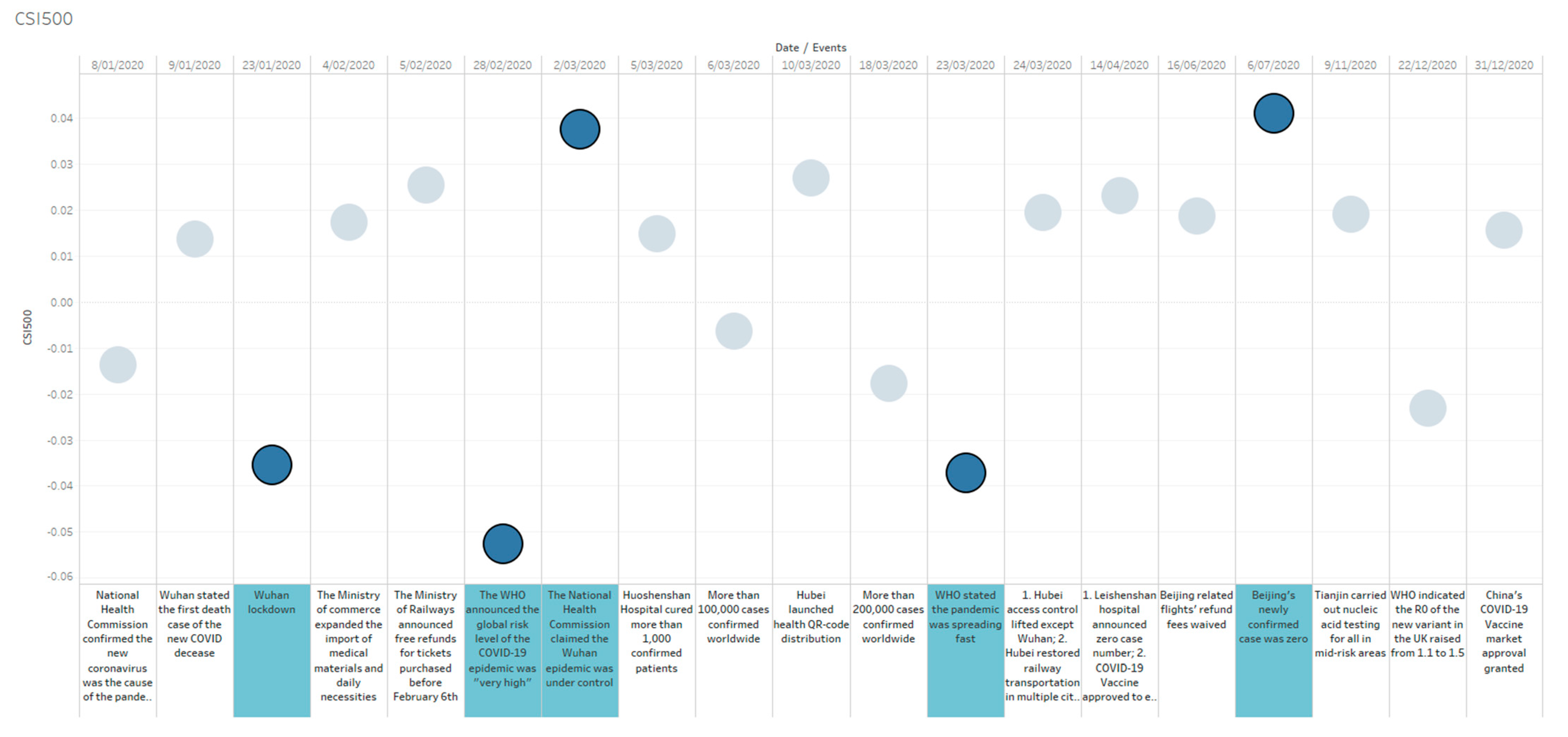
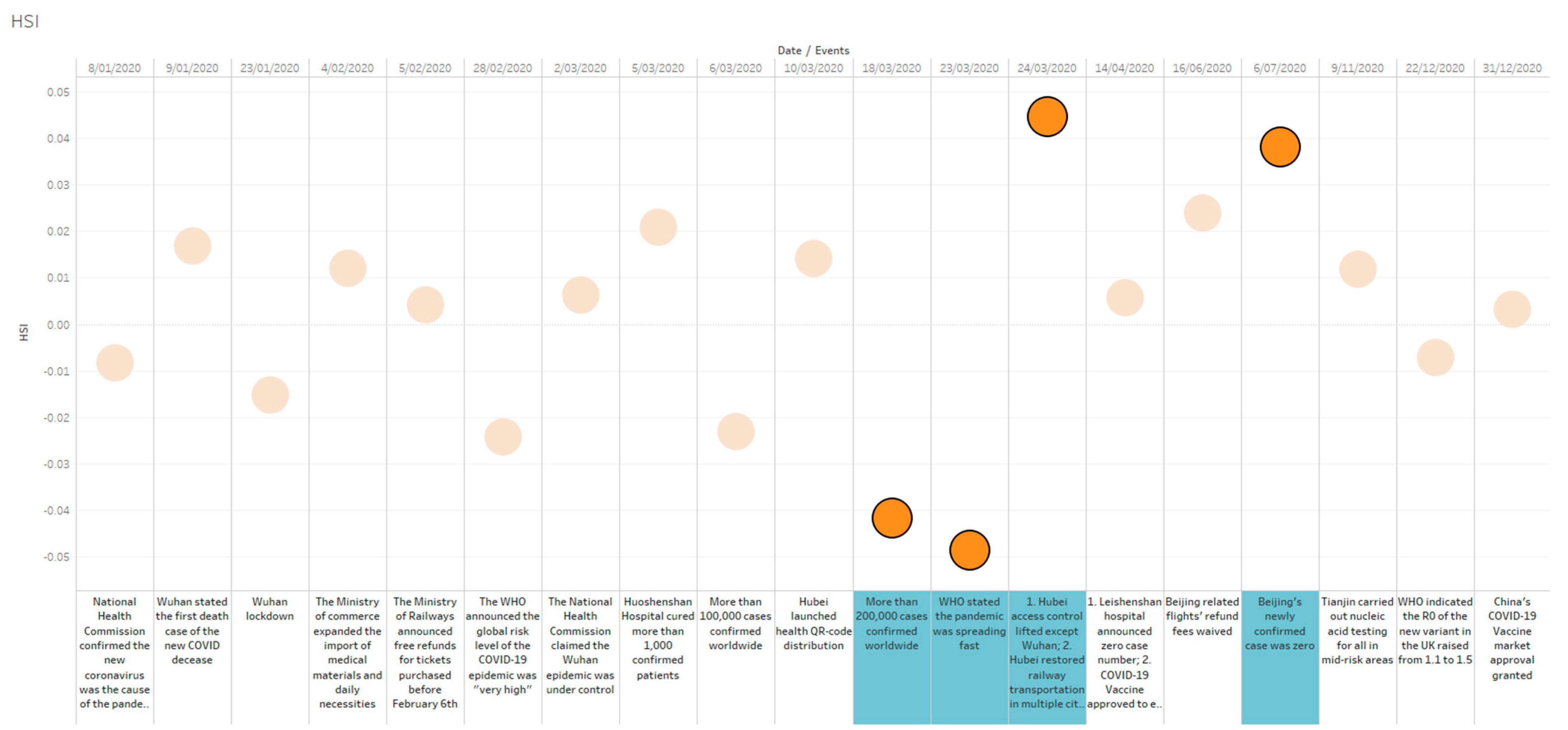
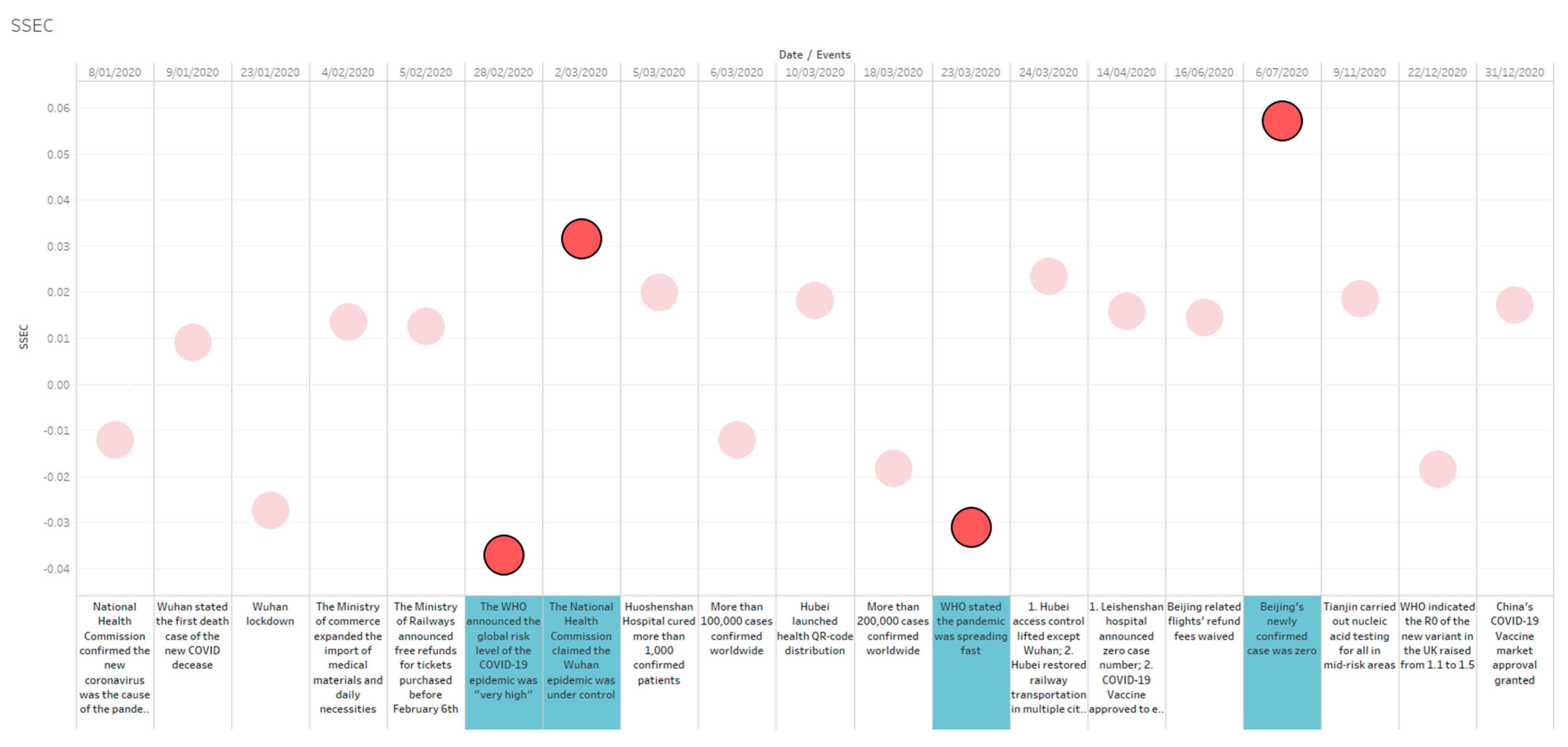
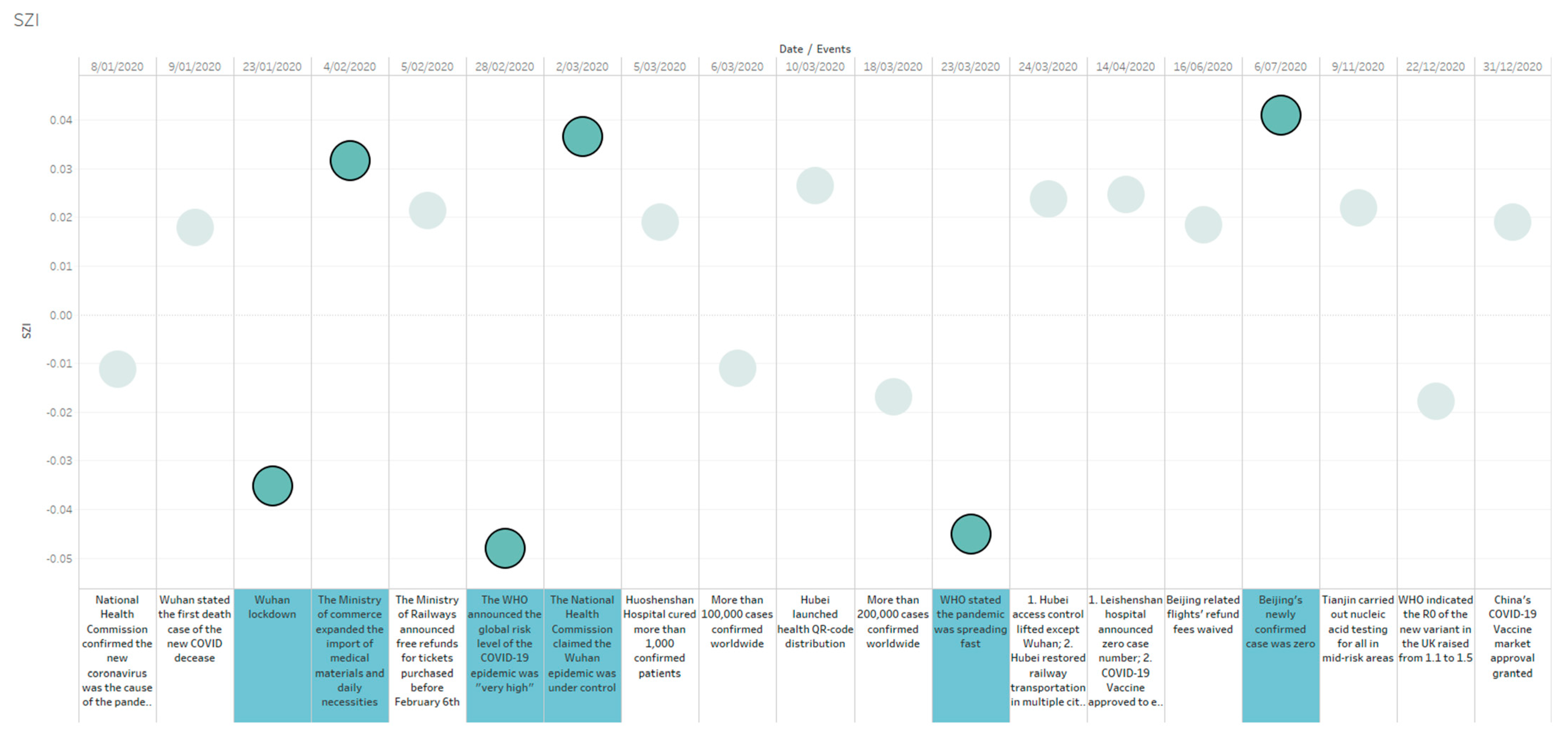
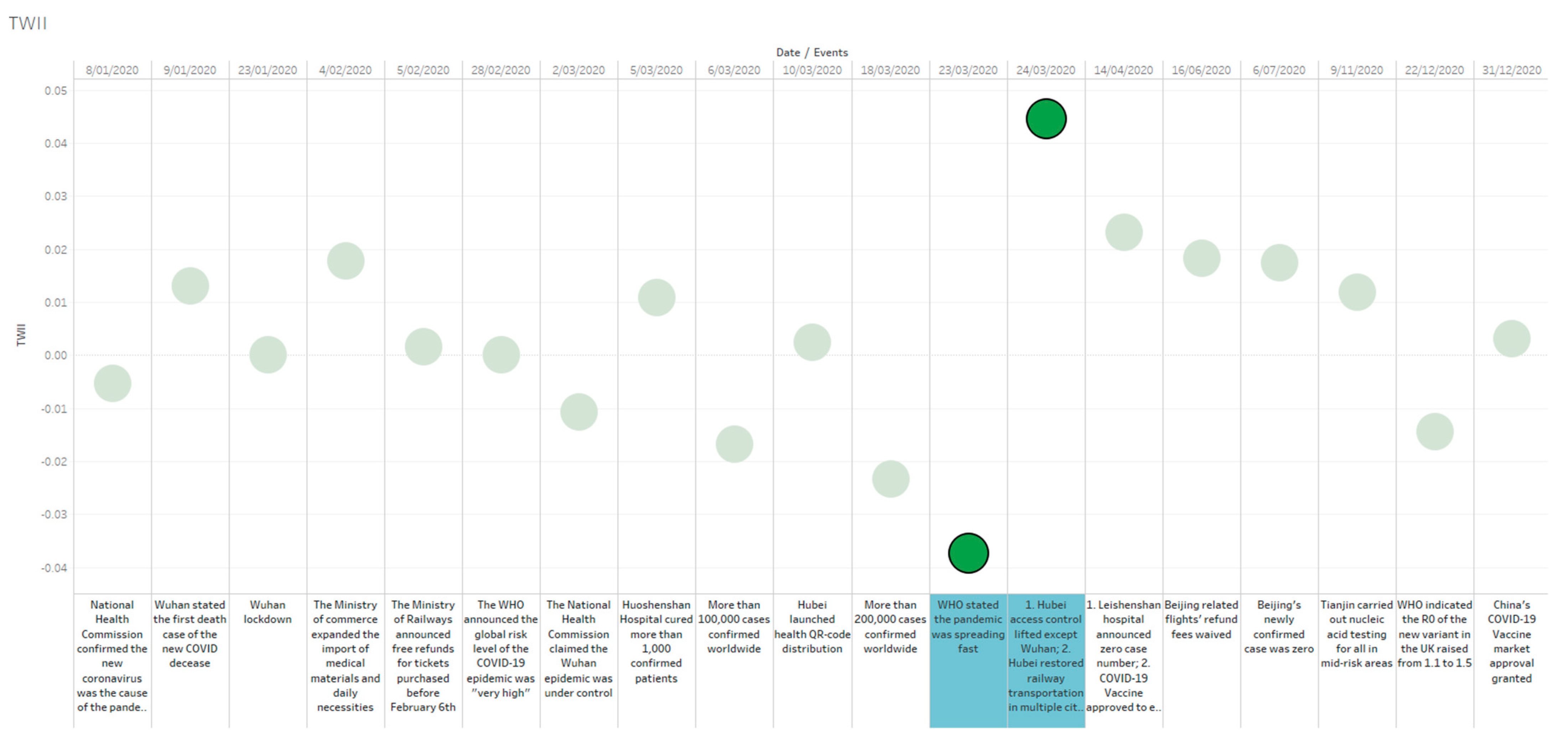
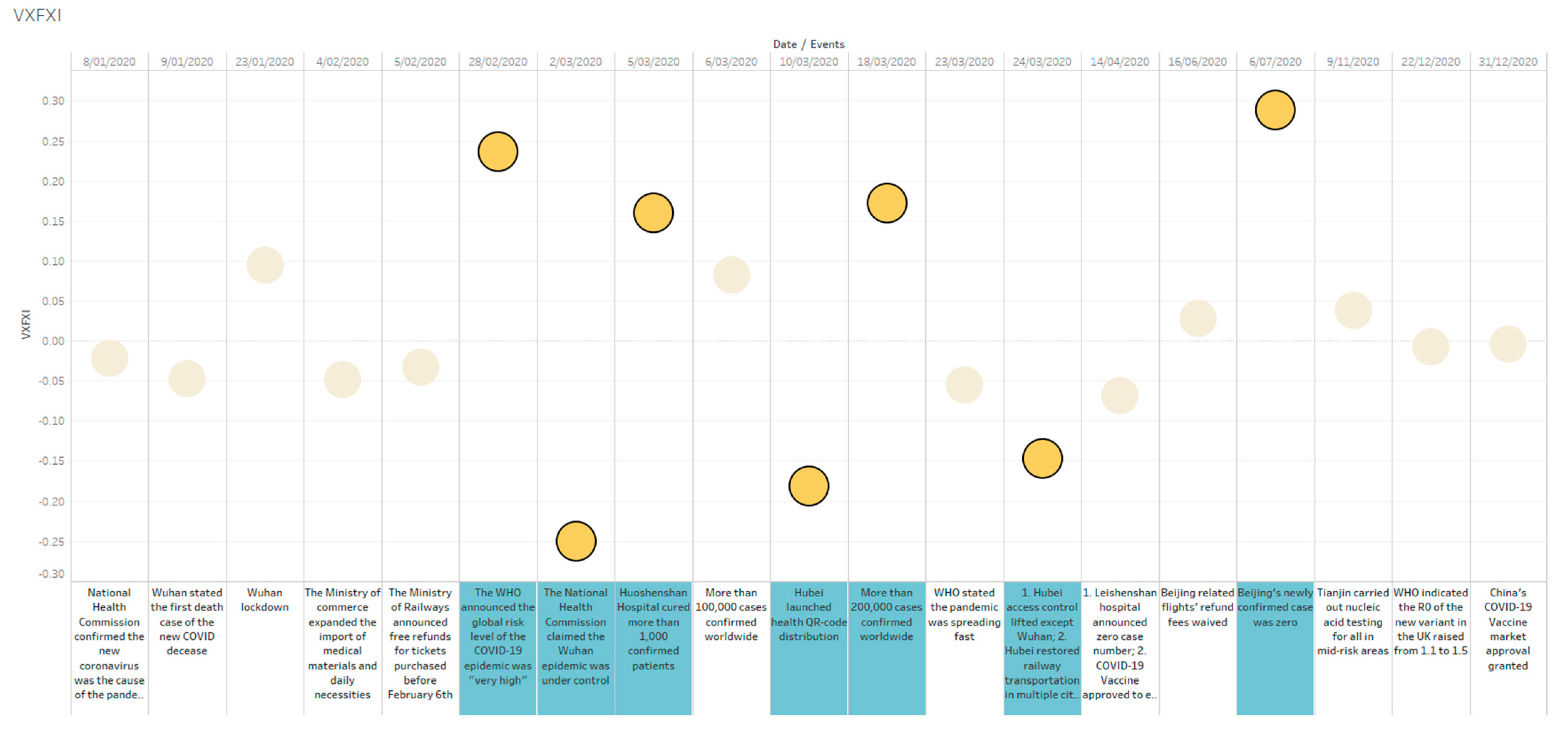
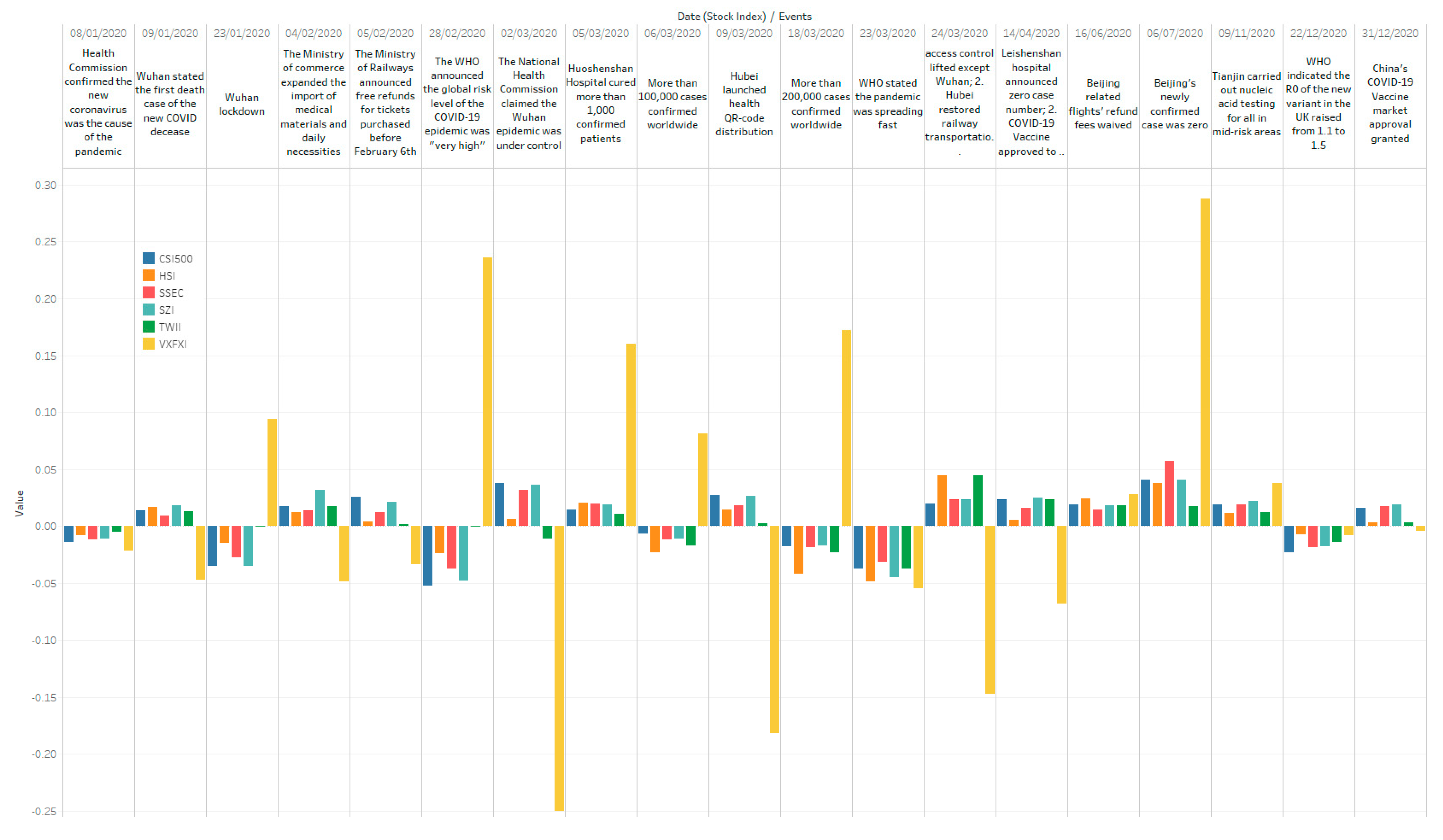
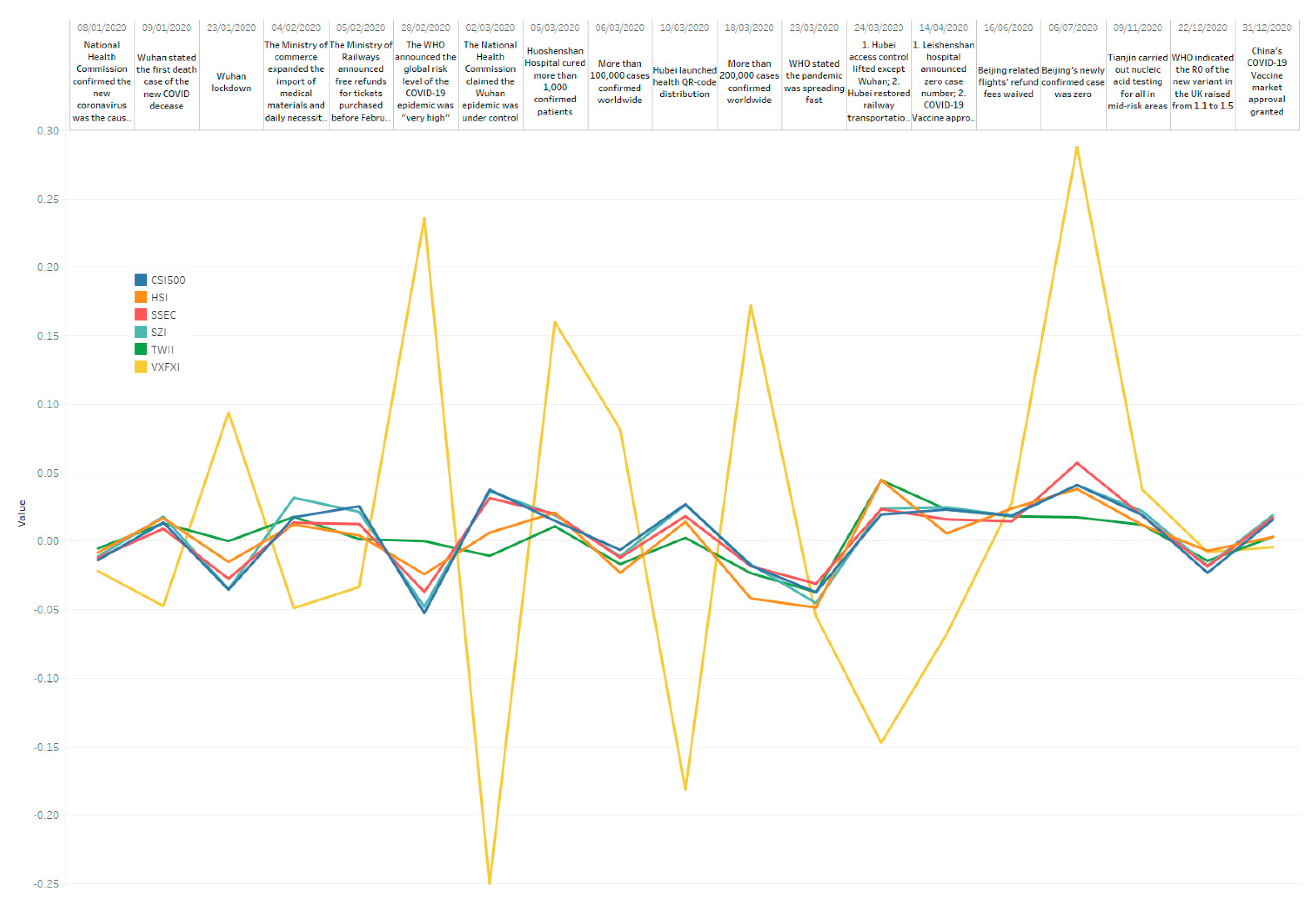


| Stock Market Index | Median Value (%) | R-Value |
|---|---|---|
| SSEC | 0.1 | 13 |
| HSI | 0.07 | 20 |
| SZI | 0.19 | 9 |
| CSI500 | 0.11 | 15 |
| TWII | 0.20 | 6 |
| VXFXI | −0.74 | 9 |
| Event ID | Event | Event Type |
|---|---|---|
| 0 | National Health Commission confirmed the new coronavirus was the cause of the pandemic | Negative |
| 1 | Wuhan stated the first death case of the new COVID decease | Negative |
| 2 | Wuhan lockdown | Negative |
| 3 | The Ministry of commerce expanded the import of medical materials and daily necessities | Positive |
| 4 | The Ministry of Railways announced free refunds for tickets purchased before 06 February | Positive |
| 5 | The WHO announced the global risk level of the COVID-19 epidemic was ’very high’ | Negative |
| 6 | The National Health Commission claimed the Wuhan epidemic was under control | Positive |
| 7 | Huoshenshan Hospital cured more than 1,000 confirmed patients | Positive |
| 8 | More than 100,000 cases confirmed worldwide | Negative |
| 9 | Hubei launched health QR-code distribution | Positive |
| 10 | More than 200,000 cases confirmed worldwide | Negative |
| 11 | The WHO stated the pandemic was spreading fast | Negative |
| 12 | 1. Hubei access control lifted except Wuhan; 2. Hubei restored railway transportation in multiple cities | Positive |
| 13 | 1. Leishenshan hospital announced zero case number; 2. COVID-19 vaccine approved to enter clinical trials in China | Positive |
| 14 | Beijing-related flights’ refund fees waived | Positive |
| 15 | Beijing’s newly confirmed case was zero | Positive |
| 16 | Tianjin carried out nucleic acid testing for all in mid-risk areas | Positive |
| 17 | WHO indicated the R0 of the new variant in the UK raised from 1.1 to 1.5 | Negative |
| 18 | China’s COVID-19 vaccine market approval granted | Positive |
| Stock Index | Event ID (Rise) | Event ID (Fall) |
|---|---|---|
| SSEC | 6, 15 | 5, 11 |
| HSI | 12, 15 | 10, 11 |
| SZI | 3, 6, 15 | 2, 5, 11 |
| CSI500 | 6, 15 | 2, 5, 11 |
| TWII | 12 | 11 |
| VXFXI | 5, 7, 10, 15 | 6, 9, 12 |
| Event ID | Events | SSEC | HSI | SZI | CSI500 | TWII | VXFXI |
|---|---|---|---|---|---|---|---|
| 5 | The WHO announced the global risk level of the COVID-19 epidemic was ‘very high’ | −3.71 | −2.42 | −4.8 | −5.26 | 23.61 | |
| 6 | The National Health Commission claimed the Wuhan epidemic was under control | 3.15 | 0.62 | 3.65 | 3.76 | −1.08 | −25.01 |
| 11 | The WHO stated the pandemic was spreading fast | −3.11 | −4.86 | −4.52 | −3.73 | −3.73 | −5.49 |
| 12 | 1. Hubei access control lifted except Wuhan; 2. Hubei restored railway transportation in multiple cities | 2.34 | 4.46 | 2.37 | 1.94 | 4.45 | −14.71 |
| 15 | Beijing’s newly confirmed case was zero | 5.71 | 3.81 | 4.09 | 4.1 | 1.74 | 28.8 |
| R2 | SSEC | HSI | SZI | CSI500 | TWII |
|---|---|---|---|---|---|
| SSEC | 1 | 0.717477 | 0.912318 | 0.920767 | 0.494731 |
| HSI | 0.717477 | 1 | 0.683696 | 0.61866 | 0.815579 |
| SZI | 0.912318 | 0.683696 | 1 | 0.972093 | 0.573557 |
| CSI500 | 0.920767 | 0.61866 | 0.972093 | 1 | 0.476764 |
| TWII | 0.494731 | 0.815579 | 0.573557 | 0.476764 | 1 |
| VXFXI | 0.033837 | 0.032358 | 0.113194 | 0.124431 | 0.003594 |
| Stock Index | Positive Event | Negative Event |
|---|---|---|
| SSEC | 1.82 | −1.845 |
| HSI | 1.21 | −1.92 |
| SZI | 2.37 | −1.745 |
| CSI500 | 1.94 | −2.05 |
| TWII | 1.19 | −1.56 |
| VXFXI | −3.35 | 3.68 |
Publisher’s Note: MDPI stays neutral with regard to jurisdictional claims in published maps and institutional affiliations. |
© 2021 by the authors. Licensee MDPI, Basel, Switzerland. This article is an open access article distributed under the terms and conditions of the Creative Commons Attribution (CC BY) license (https://creativecommons.org/licenses/by/4.0/).
Share and Cite
Zhou, R.; Hua, J.; Chi, X.; Ren, X.; Hua, S. An Approach for the Relationship Analysis between Social Events and the Stock Market during the Pandemic. Appl. Sci. 2021, 11, 8838. https://doi.org/10.3390/app11198838
Zhou R, Hua J, Chi X, Ren X, Hua S. An Approach for the Relationship Analysis between Social Events and the Stock Market during the Pandemic. Applied Sciences. 2021; 11(19):8838. https://doi.org/10.3390/app11198838
Chicago/Turabian StyleZhou, Ruogu, Jie Hua, Xin Chi, Xiao Ren, and Shuyang Hua. 2021. "An Approach for the Relationship Analysis between Social Events and the Stock Market during the Pandemic" Applied Sciences 11, no. 19: 8838. https://doi.org/10.3390/app11198838
APA StyleZhou, R., Hua, J., Chi, X., Ren, X., & Hua, S. (2021). An Approach for the Relationship Analysis between Social Events and the Stock Market during the Pandemic. Applied Sciences, 11(19), 8838. https://doi.org/10.3390/app11198838






